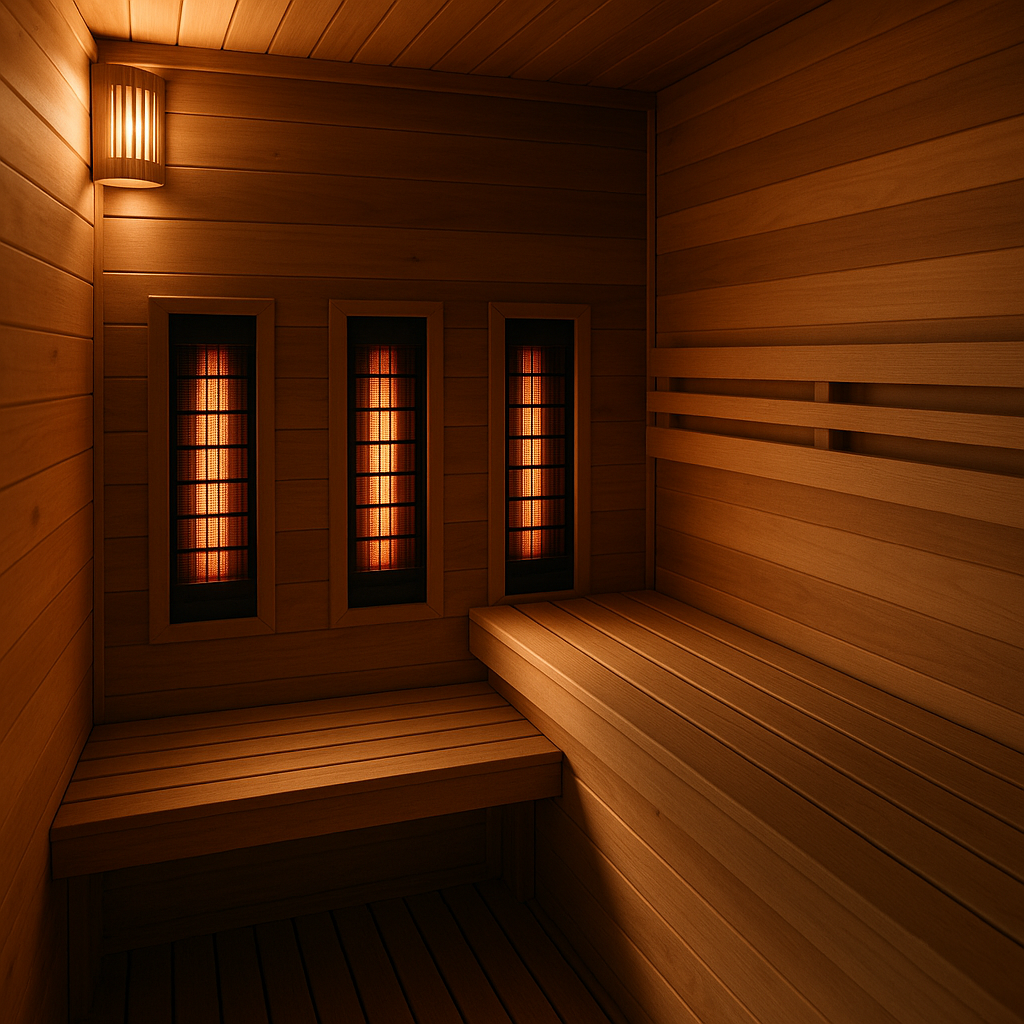The Complete Guide to Low EMF Infrared Saunas: Safety, Benefits, and What to Look For
Infrared saunas have transformed home wellness routines, offering everything from deep relaxation to potential detoxification benefits. But as these devices have grown in popularity, so has awareness about electromagnetic field (EMF) exposure. For health-conscious users, finding an infrared sauna with low EMF emissions has become just as important as the heat therapy itself.
If you're considering adding a sauna to your home, understanding EMF levels isn't just about following trends—it's about making an informed choice for your long-term wellness. This guide breaks down everything you need to know about low EMF infrared saunas, backed by recent research and real-world experiences.
Why EMF Levels Matter in Infrared Saunas
Electromagnetic fields are invisible areas of energy produced by electrical devices. In infrared saunas, EMF comes primarily from the heating elements and electrical wiring. While the science on long-term, low-level EMF exposure continues to evolve, many users report immediate improvements after switching to low EMF models.
The difference can be striking. Users of standard infrared saunas sometimes experience subtle symptoms like headaches, fatigue, or a "buzzing" sensation during or after sessions. After switching to near-zero EMF models, many report these symptoms disappear entirely, leaving only the intended benefits: deeper relaxation, better sleep, and overall improved well-being.
What the Research Shows
Recent studies highlight why EMF reduction in wellness devices deserves attention. A systematic review published in Environmental Health Perspectives found that chronic EMF exposure above 3 milligauss (mG) may be associated with sleep disturbances and headaches in sensitive individuals, though most quality consumer saunas can achieve near-zero EMF with proper shielding.
According to the World Health Organization, while causal links between low-level EMF and major diseases remain unproven, the precautionary principle is recommended for frequent, close-range exposure. This is particularly relevant for sauna users who may spend 20-40 minutes in close proximity to heating elements several times per week.
A meta-analysis in the International Journal of Environmental Research and Public Health showed that low EMF infrared saunas pose substantially less cumulative exposure compared to older, unshielded models—up to 95% reduction in average EMF output. For families with children or individuals with chronic health concerns, this reduction provides meaningful peace of mind.
Understanding EMF Levels: What the Numbers Mean
When shopping for a sauna, you'll encounter EMF measurements in milligauss (mG). Here's how different sauna types compare:
Standard Infrared Saunas: 10-30 mG These older or budget models use basic heaters with minimal or no shielding. While they provide heat therapy benefits, the EMF exposure is significantly higher.
Low EMF Infrared Saunas: 2-5 mG These models feature advanced carbon or ceramic heaters with partial shielding, striking a balance between cost and EMF reduction.
Near Zero EMF Saunas: <1 mG Premium models with comprehensive shielding and advanced engineering keep EMF levels below 1 mG—often lower than common household devices like Wi-Fi routers or microwaves.
For context, health agencies in Canada and Germany recommend residential EMF exposure remain below 1-3 mG, a standard that near-zero EMF saunas consistently meet or exceed.
Real-World Impact: Case Studies
The Morris family's experience illustrates why EMF levels matter. After purchasing a standard infrared sauna, they initially enjoyed the relaxation benefits. But after a few months, unexplained fatigue and headaches became concerning. When they upgraded to a near-zero EMF model, those symptoms vanished while the wellness benefits continued.
A wellness center in Silicon Valley saw similar results on a larger scale. After upgrading all infrared saunas to ultra-low EMF models, client satisfaction scores jumped 30%, and repeat bookings increased substantially. The center's director noted that their tech-savvy, health-conscious clientele specifically valued the reduced EMF exposure.
A University of Toronto study found that users of near-zero EMF saunas reported a 40% reduction in EMF-related symptoms compared to those using standard infrared models. The research also highlighted that children and pregnant women benefited most from the reduced exposure—important considerations for family wellness spaces.
Key Features to Look for in a Low EMF Sauna
Independent Certification
Don't rely solely on marketing claims. Look for third-party testing from organizations like TÜV Rheinland or SGS. Reputable manufacturers publish detailed EMF reports and welcome verification with your own EMF meter.
Heater Technology
Carbon and ceramic heaters are engineered for lower EMF output compared to older metal rod heaters. The best models combine advanced heater design with comprehensive shielding at the source.
Construction Quality
Premium materials like Canadian red cedar or hemlock not only enhance durability and aesthetics but contribute to better EMF performance when paired with proper electrical layout and shielding.
Comprehensive Shielding
Top-tier saunas don't just reduce EMF—they actively shield it. This involves strategic wiring layouts, grounded components, and physical barriers that block electromagnetic fields before they reach the sauna interior.
Size and Design Considerations
Beyond EMF performance, consider practical factors: available space, number of users (1-person to 4-person models), ergonomic seating, ventilation, and ease of cleaning. Modern digital controls with precise temperature settings and safety features add convenience and peace of mind.
Exploring Your Options
When you're ready to invest in a low EMF sauna, having a clear understanding of your space, budget, and wellness goals makes the decision easier. Whether you're drawn to infrared saunas for their efficient heat therapy or considering a hybrid sauna that combines traditional and infrared benefits, prioritizing EMF certification ensures you're making the safest choice.
For those with limited space, compact models offer all the benefits of low EMF technology without requiring a dedicated room. Families or those who enjoy social wellness sessions might prefer spacious 3-4 person units that maintain ultra-low EMF levels even with multiple heating elements.
Top Brands Leading the Low EMF Movement
Several manufacturers have made EMF reduction a core part of their design philosophy:
Sunlighten's mPulse Series documents emissions below 1 mG with regular third-party certifications. Their models often include customizable chromotherapy (color light therapy) and preset wellness programs.
Dynamic Saunas offers the "Valley" series with ultra-low EMF output, ideal for compact spaces while maintaining rigorous safety standards.
Maxxus produces the "Elite" line featuring advanced shielding and premium Canadian red cedar construction, with models ranging from intimate 1-person units to spacious 4-person saunas.
Each of these brands provides transparent EMF testing results and backs their products with comprehensive warranties—key indicators of quality and confidence.
Making the Right Investment
Choosing a near-zero EMF sauna often means a higher upfront cost compared to standard models, but the investment pays dividends for frequent users. Beyond the health and safety benefits, these premium saunas typically feature:
- Energy-efficient operation that reduces long-term utility costs
- Durable construction that lasts decades with minimal maintenance
- Modern conveniences like Bluetooth audio, chromotherapy lighting, and intuitive controls
- Higher resale value due to growing EMF awareness among buyers
For dedicated wellness enthusiasts, families with children, or anyone with heightened EMF sensitivity, the peace of mind alone justifies the premium. You're not just buying a sauna—you're investing in daily wellness without compromise.
Beyond EMF: Maximizing Your Sauna Experience
While EMF levels are crucial, they're just one factor in creating an optimal sauna experience. Consider these additional elements:
Location: Indoor saunas offer year-round convenience and climate control, while outdoor models provide a nature-connected experience and often more flexible placement options.
Traditional vs. Infrared: If EMF is your primary concern, traditional steam saunas emit virtually no EMF. However, infrared saunas operate at lower temperatures and heat the body more directly, making them accessible for longer sessions.
Maintenance: Quality low EMF saunas require minimal upkeep—occasional wood treatment, keeping vents clear, and basic electrical inspections ensure longevity.
Session Optimization: Most experts recommend 2-4 sessions per week, lasting 20-40 minutes. Stay well-hydrated before and after, and listen to your body's signals.
The Future of Sauna Safety
As awareness grows, EMF standards are becoming stricter and consumer expectations higher. Leading manufacturers continue innovating, pushing EMF levels even lower while adding features that enhance the overall wellness experience.
The EMF Safety Network regularly publishes independent lab results, giving consumers transparent, verified data to guide their purchases. This trend toward accountability and third-party verification is raising the bar across the industry.
For anyone serious about home wellness, low EMF is no longer a premium option—it's becoming the baseline standard for quality infrared saunas.
Frequently Asked Questions
What exactly is EMF and why should I care about it in my sauna?
EMF stands for electromagnetic fields, which are produced by all electrical devices. In saunas, heating elements and wiring generate EMF that you're exposed to during sessions. While research on long-term low-level exposure continues, many users report sensitivity symptoms like headaches, fatigue, or sleep disturbances from high-EMF saunas. Choosing a low EMF model minimizes these concerns while preserving all the heat therapy benefits.
How can I verify a sauna is truly low EMF?
Always request independent lab certifications and published EMF readings from reputable testing organizations like TÜV Rheinland or SGS. Don't rely solely on marketing claims. You can also purchase an EMF meter (widely available for $30-100) to test the sauna yourself upon delivery. Reputable manufacturers welcome this verification and provide detailed documentation.
Are near-zero EMF saunas worth the extra cost?
For frequent users, families with children, or anyone with EMF sensitivity, absolutely. Near-zero EMF saunas (below 1 mG) offer the highest safety standards and eliminate concerns about cumulative exposure. While they cost more upfront, the peace of mind, enhanced relaxation, and long-term wellness benefits make them a smart investment. Most users report the difference is immediately noticeable.
Can I retrofit my existing sauna to reduce EMF?
While some modifications might help—like upgrading heaters or adding shielding—it's rarely as effective as purchasing a purpose-built low EMF sauna. The engineering required to achieve near-zero EMF involves the entire electrical system, wiring layout, and structural design. Retrofitting typically can't achieve the same low levels and may void warranties.
How do low EMF infrared saunas compare to traditional steam saunas for EMF exposure?
Traditional steam saunas produce virtually no EMF since they use heated stones or simple electric heating elements with minimal electronics. If EMF is your primary concern and you're open to either type, traditional saunas offer the lowest exposure. However, infrared saunas provide unique benefits—direct body heating, lower operating temperatures, and more energy efficiency—making certified low EMF infrared models an excellent choice for those who prefer infrared therapy.
What's the difference between "low EMF" and "near-zero EMF"?
Low EMF typically refers to saunas emitting 2-5 mG, while near-zero EMF models emit less than 1 mG—often as low as 0.1-0.3 mG. Near-zero EMF saunas use more advanced shielding and engineering to achieve the absolute lowest possible exposure. For most users, either is significantly safer than standard saunas (10-30 mG), but those with heightened sensitivity or using saunas daily often prefer near-zero models.
How often should I use a low EMF infrared sauna?
Most wellness experts recommend 2-4 sessions per week, with each session lasting 20-40 minutes. Your ideal frequency depends on your health goals, tolerance to heat, and schedule. Start with shorter, less frequent sessions and gradually increase as your body adapts. Always hydrate well before and after, and consult your physician if you have underlying health conditions.
Which materials are best for low EMF sauna construction?
Canadian red cedar, hemlock, and aspen are popular premium wood choices that enhance durability, appearance, and performance. While wood type doesn't directly affect EMF levels, it works in concert with proper electrical shielding and heater placement. Quality low EMF saunas combine premium materials with advanced engineering—both matter for optimal results.
Can I use a low EMF sauna if I have a pacemaker or other medical device?
Always consult your physician before using any sauna if you have a pacemaker, implanted defibrillator, or other medical device. While low EMF models are safer, individual medical circumstances vary significantly. Your doctor can assess whether sauna use is appropriate for your specific situation and advise on any necessary precautions.
Do low EMF saunas take longer to heat up or work less effectively?
No. Low EMF design doesn't compromise heating performance or temperature range. These saunas deliver the same infrared heat therapy as standard models—the difference is in the shielding and electrical engineering that reduces EMF exposure. You'll experience the same warmth, same therapeutic benefits, and same energy efficiency, just with significantly lower electromagnetic field exposure.
Where can I find reliable reviews and comparisons of low EMF saunas?
The EMF Safety Network publishes independent lab testing results and consumer reports. For a curated selection of low EMF models with detailed specifications, explore quality sauna options that prioritize both performance and safety. Reading verified customer reviews from multiple sources gives you real-world insights into EMF levels, ease of assembly, and long-term satisfaction.
How does EMF in saunas compare to other household sources?
Most near-zero EMF saunas emit less EMF than common devices like Wi-Fi routers, microwaves, or even hair dryers. Standard infrared saunas (10-30 mG) emit more, comparable to standing very close to a microwave while it operates. The key difference is duration and proximity—you spend 20-40 minutes inside a sauna, often in direct contact with surfaces, making EMF reduction more impactful than with devices you use briefly or from a distance.










Leave a comment
This site is protected by hCaptcha and the hCaptcha Privacy Policy and Terms of Service apply.